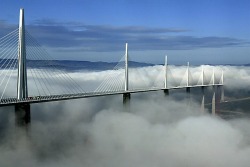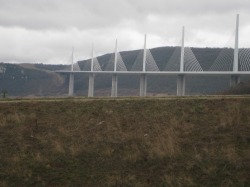The Millau Bridge, Millau, France

The Millau Viaduct (French: le Viaduc de Millau) is a large cable-stayed road-bridge that spans the valley of the river Tarn near Millau in southern France. Designed by the structural engineer Michel Virlogeux and British architect Norman Foster, it is the tallest vehicular bridge in the world, with one mast's summit at 343 metres (1,125 ft) — slightly taller than the Eiffel Tower and only 38 m (125 ft) shorter than the Empire State Building. The viaduct is part of the A75-A71 autoroute axis from Paris to Béziers. It was formally dedicated on 14 December 2004, inaugurated the day after and opened to traffic two days later. The bridge won the 2006 IABSEOutstanding Structure Award.[1]
[edit]Construction recordsThe bridge’s construction broke three world records:
The record for highest bridge deck in the world is likely to be taken by the Chenab Bridge in the Reasi District of Jammu and Kashmir, India, scheduled for completion in December 2009, which will be 359 metres (1,180 ft) high. [2]
[edit]LocationThe Millau viaduct, and the town of Millau on the rightThe Millau Viaduct is located on the territory of the communes of Millau and Creissels, France, in the département of Aveyron. Before the bridge was constructed, traffic had to descend into the Tarn River valley and pass along the route nationale N9 near the town of Millau, causing heavy congestion at the beginning and end of the July and August vacation season. The bridge now traverses the Tarn valley above its lowest point, linking two limestone plateaux, the Causse du Larzac and the Causse Rouge, and is inside the perimeter of the Grands Causses regional natural park.
The bridge forms the last link of the A75 autoroute, (la Méridienne) from Clermont-Ferrand to Pézenas (to be extended to Béziers by 2010). The A75, with the A10 and A71, provides a continuous high-speed route south from Paris through Clermont-Ferrand to the Languedoc region and through to Spain, considerably reducing the cost of vehicle traffic travelling along this route. Many tourists heading to southern France andSpain follow this route because it is direct and without tolls for the 340 kilometres (210 mi) between Clermont-Ferrand and Pézenas, except for the bridge itself.
The Eiffage group, which constructed the viaduct, also operates it, under a government contract which allows the company to collect tolls for up to 75 years. The toll bridge costs €5.60 for light automobiles (€7.40 during the peak months of July and August).
[edit]North-South axesThe four route options for Perpignan–ParisAs of 2007, there are four north-south routes, or axes, traversingFrance:
[edit]A75 autorouteConstruction started in 1975 and was finished in 2004 when the Millau Viaduct went into service.
The new A75 autoroute, complementing the A71 from Orléans toClermont-Ferrand, created a fourth route through France and has several advantages:
[edit]Bypassing Tarn at MillauThe Tarn flows from the east to the west of France, south of the Massif Central, bisecting the country's North-South axis.
For nearly thirty years prior to the construction of the Millau Viaduct, the A75 autoroute had remained unfinished. Before the bridge, a crossing of the River Tarn was provided by a bridge situated in the valley bottom, in the town of Millau. Millau was then known and dreaded as a ‘great black spot’ of motoring. Kilometres of congestion and hours of waiting to transit the town recurred each year with the great surge in traffic in summer months. These slowdowns meant that the advantages of the A75 were lost. The A75 was meant to be a positive example of spatial planning, a modern, direct highway entirely free along its 340 km (210 mi) length. As it was, the traffic from the autoroute brought pollution and danger to the town of Millau.
Design and construction of the bridge took a long time. In this region, climatic conditions are tough, with violent winds. Geological characteristics of the high plateaus of Larzac are peculiar, and, because the Tarn Valley is so deep, crossing is difficult. Different approaches were investigated, and all of them were found to be very technically demanding. Ten years of research and four years of implementation were required for completion of the Millau Viaduct.
[edit]DescriptionThe Millau Viaduct consists of an eight-span steel roadway supported by seven concrete pylons. The roadway weighs 36,000 tonnes and is 2,460 m (8,100 ft) long, measuring 32 m (100 ft) wide by 4.2 m (14 ft) deep, making it the world's longest cable-stayed deck. The six central spans each measure 342 m (1,120 ft) with the two outer spans measuring 204 m (670 ft). The roadway has a slope of 3% descending fromsouth to north, and curves in a plane section with a 20 km (12 mi) radius to give drivers better visibility. The pylons range in height from 77 m (250 ft) to 246 m (810 ft), and taper in their longitudinal section from 24.5 m (80 ft) at the base to 11 m (36 ft) at the deck. Each pylon is composed of 16 framework sections, each weighing 2,230 tons. These sections were assembled on site from pieces of 60 tons, 4 m (13 ft) wide and 17 m (56 ft) long, made in factories in Lauterbourg and Fos-sur-Mer by Eiffage. The pylons each support 97 m (320 ft) tall masts.
The pylons were assembled first, together with some intermediate temporary pylons, before the decks were slid out across the piers by satellite-guided hydraulic rams that moved the deck 600 mm every 4 minutes. Then the masts were driven over the new deck, erected on top of the pylons, connected to the deck and the temporary pylons removed.
Construction began on 10 October 2001 and was intended to take three years, but weather conditions put work on the bridge behind schedule. A revised schedule aimed for the bridge to be opened in January 2005. The viaduct was inaugurated by President Chirac on 14 December 2004 to open for traffic on 16 December, several weeks ahead of the revised schedule.
The construction of the bridge was depicted in an episode of the National Geographic Channel MegaStructures series, as well as Discovery Channel's Extreme Engineering.

